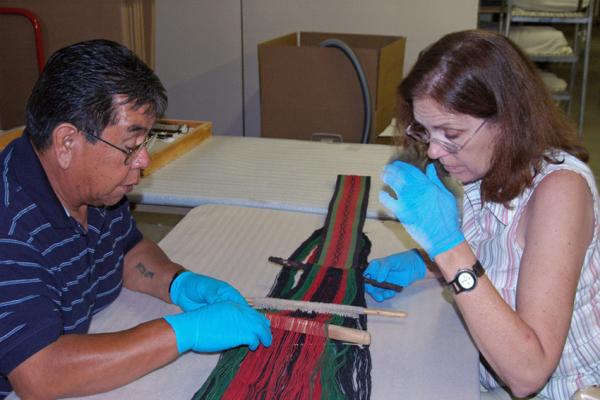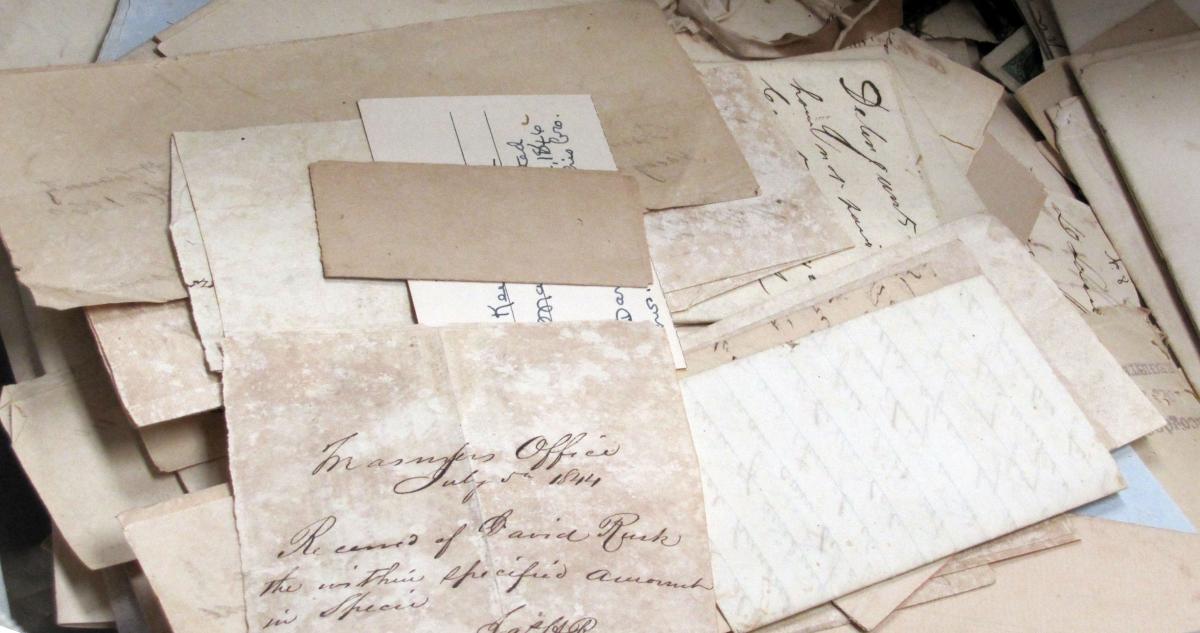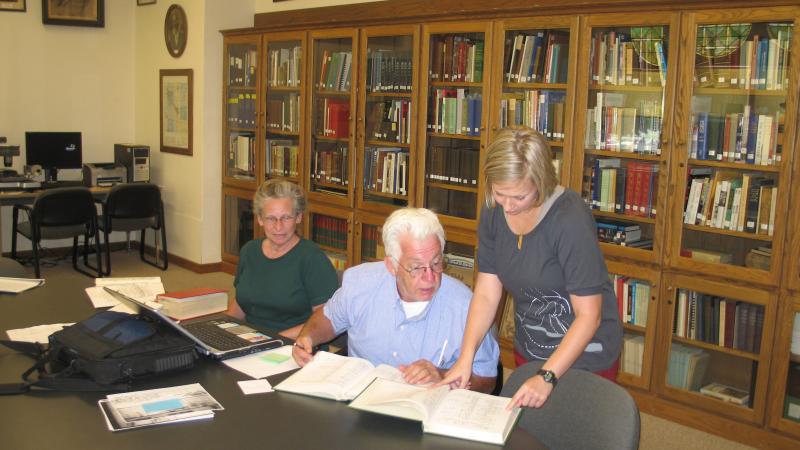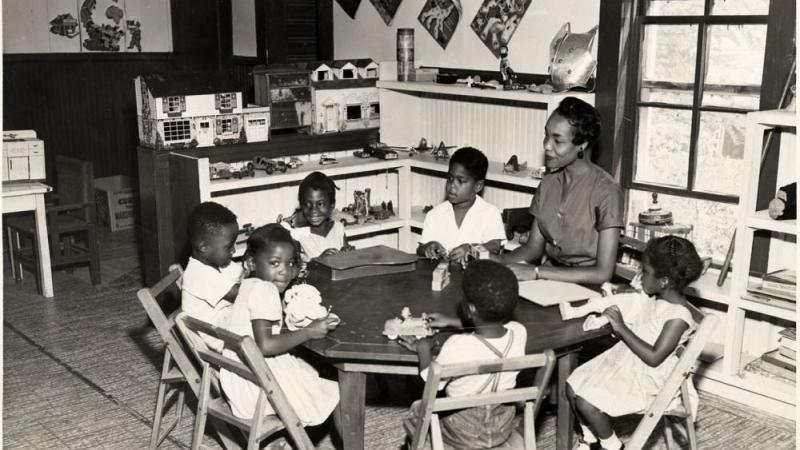Preservation Assistance Grants for Smaller Institutions Guidelines Now Available!

This image shows Austin Lomatewama, Hopi weaving instructor for Hopitutuqaiki, the Hopi School (http://www.hopischool.net/), and Cara Varnell, textile conservator, discussing a belt loom in 2007. This IMLS project focused on the development of textile storage techniques to facilitate tribal access by traditional cultural practitioners. Use of MNA collections in this manner has been occurring annually since 2005.
Courtesy of Museum of Northern Arizona.

This image shows Austin Lomatewama, Hopi weaving instructor for Hopitutuqaiki, the Hopi School (http://www.hopischool.net/), and Cara Varnell, textile conservator, discussing a belt loom in 2007. This IMLS project focused on the development of textile storage techniques to facilitate tribal access by traditional cultural practitioners. Use of MNA collections in this manner has been occurring annually since 2005.
Courtesy of Museum of Northern Arizona.
Are you a small institution with a significant humanities collection? Then you may want to apply to the NEH’s Preservation Assistance Grants for Smaller Institutions. Guidelines are available for the next deadline of January 31, 2019, and now is the right time to be planning if you want to submit an application.
Since 2000, NEH has made over 2,000 awards for Preservation Assistance Grants (commonly known as PAGs) to libraries, museums, historical societies, archival repositories, cultural organizations, town and county records offices, and colleges and universities that want to improve their ability to preserve and care for their humanities collections. In all 50 states, and in Puerto Rico, PAG awards have enabled many small and mid-sized cultural repositories to hire consultants to do a preservation assessment; purchase preservation supplies, including shelving and archival folders; and acquire environmental monitoring equipment. PAGs also support cultural heritage institutions develop disaster or environmental monitoring plans, or train their staffs in the care and storage of humanities collections or the best practices for cataloging and arranging and describing collections.
Application Information
Awards of up to $10,000 support preservation-related collection assessments, consultations, purchase of preservation supplies and equipment, training and workshops, and institutional and collaborative disaster and emergency planning.
All applications to NEH must be submitted through Grants.gov; see the application guidelines for details. The guidelines for Preservation Assistance Grants for Smaller Institutions are available at https://www.neh.gov/grants/preservation/preservation-assistance-grants-smaller-institutions. You will also find sample project descriptions, sample narratives, and a list of frequently asked questions. If you have an idea for a project that you think might fit the Preservation Assistance Grant program, or if you simply want to find out more about the program, please contact us at: @email or by phone at: 202-606-8570.
Smaller and mid-sized institutions that have never received an NEH grant are encouraged to apply. We also have a special encouragement for applications from community colleges, Hispanic-serving institutions, Historically Black Colleges and Universities, and Tribal Colleges and Universities, and from Native American tribes and Native Hawaiian and Native Alaskan organizations with significant humanities collections.
The program also encourages applications for the following activities:
- consultants working as mentors with advanced students or recent graduates from preservation programs to provide emerging preservation professionals with practical experience. Advanced students and recent graduates may assist in conducting preservation assessments, addressing specific preservation issues, and/or training staff at the applicant institution.
- the development of disaster plans and collaborative work with local institutions for training in disaster preparedness and emergency response to address the risk to cultural heritage materials from natural disasters, theft, and other types of damage.
- disaster planning, response, recovery, and mitigation; preservation assessments; conservation treatments; temporary relocation and storage of collections; purchase of supplies; education and training related to disaster planning and response; and reformatting of collections as a preservation methodology for institutions in federally declared disaster areas.
What’s New for 2019
Americans will celebrate the 250th anniversary of our nation in 2026. The anniversary of American independence provides an important opportunity to look back at the nation’s founding and the past two and a half centuries of American history. What began as a conflict between the thirteen colonies and Great Britain culminated in the creation of what would become the world’s oldest constitutional democracy. As we approach the 250th anniversary, NEH is offering a special encouragement to applicants in the PAG program to consider the impact—both immediate and long term—of the momentous events of 1776.
We especially invite applications that explore the role of the Declaration of Independence and other foundational documents in the making of U.S. history. In addition, we would welcome applications that explore the experiences of states and communities beyond the original colonies in joining the nation, since they have their own stories of becoming part of the United States. We also invite applications examining the stories and contributions of under-represented communities in our nation’s history.
In support of these themes, applications to the PAG program for up to $15,000 may be submitted for consultations and planning with one or more humanities professionals (for example, American historians, archivists, librarians, preservation specialists, and/or curators) that would position smaller institutions to undertake, at a later stage, any of the following activities:
-
cataloging and/or arranging and describing collections of publications, documents, artifacts, photographs, audiovisual materials, and other original sources pertaining to American history;
-
digitizing American history collections;
-
providing conservation treatment for original items or groups of items relating to American history; and
-
partnering with cultural organizations, educational institutions, or other community groups for the purpose of making primary sources in American history broadly available to the public.
The program also supports consultants who would offer education and training in staff professional development geared to capacity-building and leadership that would help the institution improve its care of American history collections.
Applications to support consultations and planning for these activities may also request funds to pursue regular PAG activities (assessments, consultations, purchase of supplies/equipment, and education and training), up to a total of $15,000 for all activities.
Funded Projects Map and Examples
The interactive map pictured here shows the distribution of Preservation Assistance Grant awards made between 2000 and 2014.
If you are interested in learning about awards made in a particular state, you can zoom in by double-clicking, and if you hover over a red dot (which appears darker if there is a greater density of awards in one area), the name of the awardee will appear. Click on the name and you’ll get the project details. Or zoom out, and think about how many humanities collections are in better condition today as a result of the awards made through this grant program! To zoom in or out at will, use the plus and minus symbols on the upper right hand corner of the page.
Here are a few examples of projects that you will find:
- Part of a good preservation plan is being prepared for natural and man-made disasters. Alliance for Response, a national program on cultural heritage and disaster management, works to build bridges between the cultural heritage and emergency response communities before disasters happen. Through a PAG award, the Alliance for Response Pittsburgh (AFR Pittsburgh) built a cache of disaster response supplies to be shared by humanities organizations in the greater Pittsburgh region, and held a disaster response training workshop. In May 2012, AFR Pittsburgh held a day-long meeting explaining the purpose of the disaster supply cache and demonstrating how each of the supplies works (see image gallery). The meeting was attended by representatives from some of the most important cultural and educational institutions in the region: Allegheny College, Andy Warhol Museum, Carnegie Library of Pittsburgh, Carnegie Mellon University, Carnegie Museum of Natural History, Chatham University, Duquesne University, Heinz History Center, Pittsburgh Symphony, University of Pittsburgh, and University of Pittsburgh iSchool.
- Elkhart, Indiana, is known as the “Band Instrument Capital of the World,” home to the Selmer, Conn, and Martin manufacturing companies, and the Elkhart Historical Society maintains business records and artifacts telling this story as well as other aspects of the area’s economic, social, and cultural history, dating from the 1830s--all of which has been more effectively preserved as a result of a 2010 PAG award through the purchase of environmental monitoring equipment and storage cabinets and the services of a preservation consultant to help ensure proper use of these items.
- In 2012, the Manitou Springs Historical Society (Manitou Springs, Colorado) received a PAG to support a storage move and the training of staff in the use of environmental monitoring equipment to help ensure appropriate conditions for maintaining humanities collections at the society’s Miramont Castle, a 14,000 square-foot edifice constructed by a French missionary priest and later used as a sanitarium for the treatment of tuberculosis. Today, the museum showcases both the elaborate architecture and artifacts of the Victorian Era, and the role of Colorado and the West in health treatments during the 19th century. Collections include ceramic and glass artifacts, furniture, paintings, textiles, photographs, scrapbooks, newspapers, and postcards.
- In 2013, NEH awarded a Preservation Assistance Grant to the Southern University at Shreveport (Shreveport, Louisiana) for a comprehensive assessment of its Black Ethnic Archives, which provides a picture of everyday life and community activity during the civil rights era and beyond. The collections include the complete run of the Shreveport Sun, the oldest African American newspaper in Louisiana (1927-present); materials on notable African Americans in Shreveport; and the papers of local activists, who worked with national leaders such as Dr. King to rally local support.



